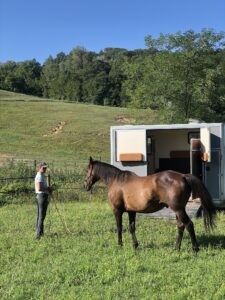For years I worked as a trail guide, and one of the skills I ensured all my lead horses had mastered down to a tee, was ground-tying.
Riding with clients of all levels occasionally presented me with unexpected emergencies that required an instant dismount where I was required to abandon my horse in order to assist them better from the ground. Once a woman almost ended backed her horse off a bridge, another while distracted, rode her horse into a large hole. Knowing that my horse would still be there when I came back was as important to me as his safety was during my absence.
Another of my lead horses picked up the dangerous habit of pulling back while tied to anything solid.
Even after many attempts to remedy the habit, he was still never 100% reliable when tied to a fence post or hitching rail. I noticed however, that even though he would literally flip himself backwards if he was tied solid, he would stand for hours like a lamb if I tied him to anything with some flex to it (ie. a small branch, or small hedgerow). Since it’s not always possible to find flexible vegetation out on long rides, but seeing how well he could stand, gave me the idea to teach him to ground-tie instead. He learnt this skill faster than any of my horses and was soon so reliable that I could leave him standing free during long lunch breaks, or while tacking up, safe in the knowledge he would not leave his post.

In an ideal world, every horse should be able to stop and stand put with or without a rider on his back. Teaching a horse to wait quietly wherever you leave him can be one of the most useful skills you teach him, both from the point of view of convenience and that of his safety on the trail. A ground-tied horse is more versatile, pleasurable, and reliable for his rider than one without this skill.
Whether it’s stepping away to grab something out of the car, open a gate or clear a branch from the trail- ground tying comes in handy anytime there is nowhere to safely tie your horse. A horse that is trained to ground-tie is less likely to get caught up in wire or brambles and is more likely to stand quietly while waiting for someone to come to the rescue than a horse that does not have this skill.
Ground-tying is not difficult to teach a horse, but it does require patience, practice and time.
There are different techniques around, but here is what worked for my horses.
What you need:
· A rope halter.
· A long lead or lunge rope.
· A whip or carrot stick (or your hand will do).
· A safe place to practice without any distractions or hazards.
How to teach your horse to ground tie.
Once you have your horse and equipment read, you can begin your horse’s training.
Be sure to choose a moment when he is calm and relaxed. The ideal time is after you have ridden or lunged him, since he will be mentally and physically ready to stand quietly. Ground-tying is a skill that must be practiced continuously. With practice you’ll find that the horse will stand quietly for longer and longer without fidgeting or moving out of position.
Ensure that the horse is standing squarely so that he is comfortable. With your horse tacked up but wearing just a rope halter instead of a bridle, let the lead rein drop to the ground and take the lead rope in your hand around ten cm under where it is tied to the halter and give it a soft tug; and at the same time say the word, “woah.”
Back away from the horse while facing him with one hand raised and palm towards him (or if you prefer to use a whip or carrot stick, you can raise it in the same manner).
Move back a short distance away from him to begin with, wait a moment, then return and praise him (I like to also use treats when it is appropriate).
Gradually extend the distance and time.
Corrections
If your horse tries to follow you, step toward him and repeat the “woah” command firmly.
You will probably need to correct your horse while he is learning this trick. A firm “no” for moving out of his position may stop him in his tracks, but if he continues to move towards you, you follow up the verbal command by giving the rope life and shaking it vigorously to encourage him to back up. The timing for corrections should be immediate (within two seconds), as should the release of pressure as soon as he is back in his original position.
At that point, stop shaking the rope and let the slack fall to the ground lifeless. The release of pressure will communicate to him where you want him to be, and that you will leave him in peace If he stays there.
With practice (this skill is learnt fastest if it is practiced regularly) you will find that you no longer need to shake the rope much – and often lifting it up or repeating the word ‘woah’ will be enough to halt him in his tracks.

Practice makes perfect
For some horses, particularly older or fidgety types, it may take many sessions for them to learn this command, while for others, standing still quietly just comes naturally. The important thing is to be insistent, consistent, and persistent.
When your horse understands what is expected of him, you can introduce distractions like other horses, noises and movement. Try moving behind and around him so that he can’t see you anymore; and if he tries to turn around to look at you, or adjust his position, just move him back into his ‘parking spot’ and repeat the word ‘woah’ firmly.
When you are riding at home, practice randomly dismounting and just commanding him to wait for you while you move about a jump stand, fill up a water bucket or play with your dog.
As your horse becomes more self-controlled and obedient, test this skill out on a hack when the right opportunity presents itself. You can try using it while you open a gate or an electric fence, or while you check the safety of a river crossing, or tricky path ahead. When you are out riding with friends, you can practice having your horse stand, while the others pass by, or ask them to pass through a gate while you hold it open, while your horse waits beside you.
This trick can be handy for if you ever need to dismount to alter a friend or client’s stirrups or check their girth – especially if they are riding a moody horse or in-season mare that doesn’t want anything to do with your horse. Back when I was a guide, having a horse that was intelligent enough to know that standing far away from lashing teeth and flying hooves gave me peace of mind to help out, with the knowledge my horse was out of danger too.
Ground-tying with reins
Once your horse is able to stand quietly in a halter you can ground tie your horse with reins. It is best to only do this using split reins or by unbuckling closed reins in a way that removes them from your horse’s stepping range. Over time, just the feeling of split reins dropped over your horse’s neck (backed up with a verbal command) will instigate your horse to stop – and this can be a lifesaver if reins are accidentally dropped while riding.
Just keep in mind that this skill is intended to be used only ever for a short time; and no horse should be expected to stand still indefinitely – especially with a bit in his mouth.
In conclusion
It is surprising the number of times it is necessary or convenient to leave a horse alone, even for just for a moment – but whether you are out on the trail or at home, the best part about teaching this skill is that you can practice it pretty much anywhere.
I often ride in areas that are not well-trod – and having a reliable horse that will wait for me while I check the condition of a trail, or the depth of a river crossing is essential for both our safety. People often give me strange looks when they see me leave my horse with reins dropped over his neck to disappear into the undergrowth and cut back brambles, but our mutual trust and understanding has been earnt over ten years of steady reassurance and practice. I’ve found that if you are able to continuously give a horse a reason to feel calm and safe, even in the scariest situations, that horse will always be less likely to panic and will instead stand quietly and wait for your assistance and reassurance instead.


